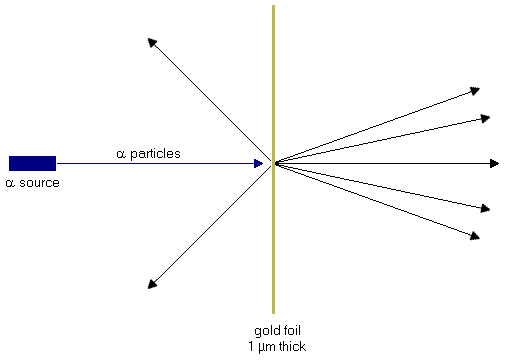| General Chemistry is a free introductory textbook on chemistry. See the editorial for more information.... |

|

Home  Atoms Atoms  The Structure of an Atom The Structure of an Atom  Scattering of alpha-Particles by Atoms Scattering of alpha-Particles by Atoms |
|||






|
|||
Scattering of alpha-Particles by AtomsAuthor: John Hutchinson
We have assumed that atoms contain positive and negative charges and the number of these charges is equal in any given atom. However, we do not know what that number is, nor do we know how those charges are arranged inside the atom. To determine the location of the charges in the atom, we perform a "scattering" experiment. The idea is straightforward: since we cannot "see" the atomic structure, then we instead "throw" things at the atom and watch the way in which these objects are deflected by the atom. Working backwards, we can then deduce what the structure of the atom must be. The atoms we choose to shoot at are gold, in the form of a very thin gold foil of thickness about 10-4 cm. The objects we "throw" are actually a particles, which are positively charged and fairly massive, emitted by radioactive polonium nuclei. The a particles are directed in a very precise narrow line perpendicular to and in the direction of the gold foil. We then look for a particles at various angles about the gold foil, looking both for particles which have been deflected as they pass through the foil or which have been reflected as they bounce off of the foil. The scattering experiment is illustrated here.
The result of the experiment is initially counter-intuitive. Most of the a particles pass through the gold foil undeflected, as if there had been nothing in their path! A smaller number of the particles are deflected sharply as they pass through the foil, and a very small fraction of the a particles are reflected backwards off of the gold foil. How can we simultaneously account for the lack of any deflection for most of the a particles and for the deflection through large angles of a very small number of particles? First, since the majority of the positively charged a particles pass through the gold foil undeflected, we can conclude that most of the volume of each gold atom is empty space, containing nothing which might deflect an a particle. Second, since a few of the positively charged a particles are deflected very sharply, then they must encounter a positively charged massive particle inside the atom. We therefore conclude that all of the positive charge and most of the mass of an atom is contained in a nucleus. The nucleus must be very small, very massive, and positively charged if it is to account for the sharp deflections. A detailed calculation based assuming this model reveals that the nucleus must be about 100,000 times smaller than the size of the atom itself. The electrons, already known to be contained in the atom, must be outside of the nucleus, since the nucleus is positively charged. They must move in the remaining space of the much larger volume of the atom. Moreover, in total, the electrons comprise less than 0.05% of the total mass of an atom. This model accounts for observation of both undeflected passage most of a particles and sharp deflection of a few. Most a particles pass through the vast empty space of the atom, which is occupied only by electron. Even the occasional encounter with one of the electrons has no effect on an a particle’s path, since each a particle is much more massive than an electron. However, the nucleus is both massive and positively charged, but it is also small. The rare encounter of an a particle with the nucleus will result in very large deflections; a head-on collision with a gold atom nucleus will send an a particle directly back to its source.
|
|||
Home  Atoms Atoms  The Structure of an Atom The Structure of an Atom  Scattering of alpha-Particles by Atoms Scattering of alpha-Particles by Atoms |
|||
Last Update: 2011-02-16


